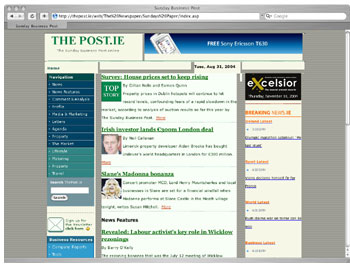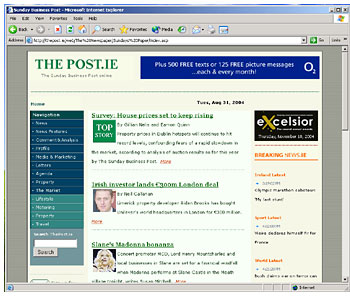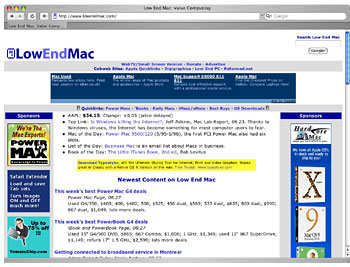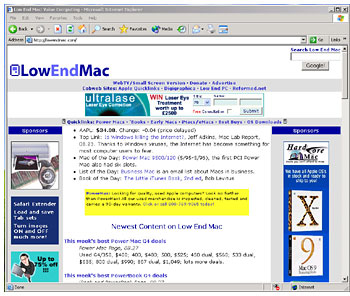It’s not uncommon for even the most Mac-oriented user to have a PC sitting in the corner. Why? Usually for testing designs. So will the prospective low-end designer need to get a Windows PC? Maybe.
It depends on what you are planning to design. For print design, no. For web design, probably.
Print design is still the preserve of the Macintosh, and even if it were not, you still would not need a PC. Once your design is finalized, you send it to the printer, and they can merrily destroy it without the need for a Windows PC.
Web design, however, is another matter altogether.
The Gross History of the Net
In the early days of Web design, it was estimated that 80% of professional sites were designed on Macs – figures 1 and 2, screen shots* of the website of a well-known Irish newspaper, the Sunday Business Post, suggests that today this is not the case.
To be fair, the site works fine in Internet Explorer for the Mac, but the rendering problems shown here do illustrate the key difference between designing for print and designing for the screen.
The reason for this is that different browsers use different techniques to render pages. A stupid idea? Not really; the Web was never meant to be a “designed” medium. Rather, its purpose is information exchange. HTML, the code which is used to layout web pages is a markup language, not a layout language.
The key consideration in a markup language is that the information encoded produces readable results while design takes a back seat. In the case of HTML, this can be traced back to the fact that the Web’s inventor, Tim Berners-Lee, originally created it to markup simple scientific papers, not to produce clean design. This had led to chaos, ugly websites, and many other problems. In recent years, attempts have been made to separate design and content though the use of the extended XHTML and CSS.
True de jure standardization is unlikely to ever arrive (or be taken seriously even if it does) but some form of de facto standardization did come with the ( many would say unfortunate) dominance of Microsoft’s browser, Internet Explorer. Griping about Microsoft aside, this solution may have worked – except for the fact that IE for Mac renders differently from IE for Windows.
Now in 2004 we’re back to where we were in 1996 – no standards. Many Windows users have abandoned IE in favor of browsers like Firefox as a response to security flaws in IE, meanwhile most Mac OS X users are using Safari. Then there’s the others on many different platforms: Camino, OmniWeb, Mozilla, Konqueror, Opera, Netscape, iCab, and who knows how many others.
Keep It Clean
Figures 3 & 4 show a familiar website in two different browsers, Safari on the Mac and Firefox on Windows. Unlike the website of the Sunday Business Post, this website looks almost identical not only in different browsers, but on different operating systems.
Low End Mac’s design has its fans and it has its detractors, but it certainly fulfills its main criterion admirably: to be useable on as wide a range of browsers as possible, particularly older browsers on older Macs.
Low End Mac (LEM) is an extreme example, but cross-platform compatibility should be a key consideration even if the site you are designing is mainly of interest to users of a single platform – as many of Low End Mac’s visitors see the site using Windows as using a Mac OS.
So, will you need a PC? It would certainly help, but there are alternatives.
The first is the most difficult – write clean HTML. If you avoid complex formatting, your design will work across platforms, from WebTV to Linux, let alone the more common Mac and PC browsers. The downside is that it is time consuming, will restrict you from using advanced design techniques, and you’ll be left to use word of mouth for testing.
The second alternative is to use an emulator to run Windows browsers.
Emulation Station
The Low End Mac Windows screen shot above wasn’t taken on a Windows machine though – it was taken on a Mac using Virtual PC (see fig. 5).
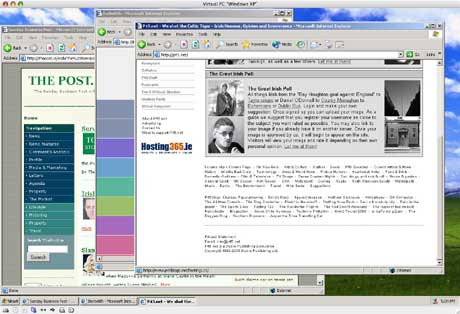
Fig. 5: Virtual PC on Mac OS X
On Mac OS X, Virtual PC is slow – very slow. To be fair, all emulators are slow, even Mac OS X’s built-in Classic Environment is slower than a native installation of Mac OS 9, and Classic doesn’t even have to bother with emulating a CPU.
Microsoft Virtual PC (VPC) for Mac OS X is rage-inducing in its sloth. I would love to blame this on Microsoft, but I cannot for two reasons.
Firstly, VPC is much zippier under Mac OS 9 – though still far from fast. Secondly, Virtual PC was originally developed by Connectix, not Microsoft.
Installation is simple – Mac simple – and VPC shares your Mac’s network settings, so there’s no need to mess around with Windows settings to get online (unless you want to). So there you have it: Windows browsers on your Mac.
Color Me Awful
Differences in browser rendering engines is, however, not the only consideration to take into account. Color is also a problem.
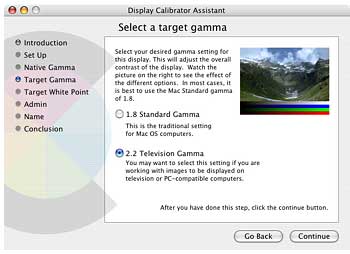 Have you ever noticed that Macs have brighter displays than PCs? That’s not just your imagination – Macs and PCs have different gamma settings.
Have you ever noticed that Macs have brighter displays than PCs? That’s not just your imagination – Macs and PCs have different gamma settings.
In print design, color calibration is key if you want your output to look as it was intended. With the Web, it’s more complex. You have no way of knowing how your site’s readers will have set up their monitors, but a good guess would be not at all.
As a rule, sites designed on Macs will appear darker on PC monitors. One way around this is to throw away your calibration and darken your Mac’s screen when you’re running Virtual PC. Figure 6 shows the process in Mac OS X. Choose the “Displays” pane, and then “Color” in System Preferences. (In the classic Mac OS, you can perform the same operation in your Monitors or Monitors and Sound control panel.)
Cheap PCs
Of course, PCs are so cheap these days that the only reason they don’t come free with your breakfast cereals is that they’re so heavy.
Do note, however, that some of the cheapest PCs – such as those at Walmart – are so inexpensive because they don’t include Windows licensing fees. How can the manufacturers do this? Simple, they don’t include Windows, often substituting Linux for Bill’s best efforts.
Putting operating system politics aside momentarily, this is of no use to us, as the only reason we would want a PC is to test sites in Windows!
- Editor’s note: Low End Mac’s low-end PC is a 450 MHz Dell Optiplex refurbished by a local dealer after use in a nearby school and sold for a measly $115 including mouse and keyboard. A Windows 98 license set us back another $40.
Alternative Emulators
Virtual PC is not the only PC emulator for the Mac. Check out the alternatives at Emulation.net.
Low End Designer Mailbag
From Simon at Gipling Press:
Hi Jason,
I have enjoyed your low end design series, as I am a professional graphic designer with a fetish for showing people what can be achieved on old and low end kit. Hell, I remember when many of my colleagues considered an LC III a professional level computer, and I myself have produced plenty of newsletters on PageMaker 4.2 running on an SE/30.
Anyway, regarding cheap printers, you didn’t mention Gimp-Print and Ghostscript. This freely downloadable setup will turn a wide number of very cheap inkjets into “Postscript” quality devices. You do need a Mac running X, though. For OS 9 setups, I believe PowerRIP performs a similar role, but that isn’t free.
Keep up the good work; good design is really about design, not what kit you use.
Simon
Thanks for your comments and tips Simon. Hopefully we’ll be able to take a look at Ghostscript and GIMP Print later; I personally use GIMP Print to drive an old Epson inkjet in Mac OS X.
Regarding your comments about what good design is, I couldn’t agree more.
All the best,
Jason
From Christopher Laspa, 999 Art Direction:
Hello Jason,
I to have been following these articles with great interest, as I too prefer to use earlier equipment that has proven highly reliable, and due to longevity of use – I am highly productive.
That said, an interesting note on the ‘PDF proof’ versus a paper printout issue. I design and create B2B/B2C websites for various SoHo clients in Toronto, which – with my 20+ years in a ‘downtown’ Toronto ad agency experience as a Senior Creative Guy – often gets me into the creation of Direct Marketing pieces on behalf of my clients. Nice work if you can get it, but now I’m back to print.
It has been my experience that with the PDF files no two digital output “environments” will output your PDF the same. Proofs or otherwise. This is especially important to know if your work is to be outputted to film with a litho press at the end. Subtle colours beware! Conversely, approving a proof on screen (Mac vs. PC gamuts/age) can also be dangerous, especially if colour is an issue. And, of course, the final: PDFs can not be altered as ‘source files’ can. Lightening overall or darkening the output is it. So a fix-on-the-fly can’t been done.
An inkjet ‘proof’ of your PDF (regardless your printer – Epson 1580 was mine) ‘can’ vary wildly from any ‘digital proof’. Moral of the story? Indeed, forget a studio printer and get your proofs done (preferably) at the end suppliers, who know their gear.
The work I do for my clients is usually 2-fold to 5″ x 5″, 4/4 digital output ‘announcement brochures’ all done on a ‘digital press’ such as a Xerox DocuColour 2060 with a Fiery RIP. File supplied is always PDF. Often there are 2-3 proofs pulled before the colour matches ‘close’. (Yes, I do have the right colour profiles, etc.) The end result is, the client sees what will be the final. Developing a great relationship with printers really helps.
Moral of the story again? Indeed, forget a studio printer and get your proofs done (preferably) at the end suppliers, who know their gear.
I mean, why bother showing your client an inkjet proof you printed out only to have to go back and alter your source files for the final output device because the press proof may be wildly off? Talk about losing credibility in your client’s eyes!
Just a point. Thanks again for the fabulous articles!
Regards,
Christopher M. Laspa Creative Director, Principal
999 Art Direction
Hi Christopher,
Thanks for the email. Personally, I prefer print design, but I suppose it’s horses for courses.
Mac vs. PC gamut is indeed an issue, especially when designing for the screen, but even if you send a PDF to a client to view.
What surprises me is the volume of mail I’ve had from high-end designers such as yourself; as you point out, your PDF will differ from printshop-to-printshop, and an in-house inkjet will vary even more. The problem is that many clients demand to see work in progress. Back when I was still a designer, I remember producing an ad for a client, a hairdresser. I brought her into the studio and told her that the colours would be inaccurate. Then I printed a copy for her. Her response? “That’s too green, I wanted it bluer than that!” After her tantrum was over, I reiterated the point about the inkjet being inaccurate and brought the ad up onscreen. Then she said, “That’s what I want! Why didn’t you print it like that?” This very same client had refused to pay for bureau-proofing.
The moral of this story? Clients, particularly low-end clients who have no staff with an understanding of the issues concerned, are usually clueless, and even explaining the situation to them is unlikely to help. If you have a client like that, get a bureau-proof. As you point out, a good relationship with your printer is essential.
The problem, as I see it, is that for many small jobs the profit margin is so small that proofing will obliterate it. It all depends on the nature of the job, of course. Being color-accurate on a job for a magazine is essential. However, if you’re producing an ad which will be printed in a newspaper, color accuracy is a moot point because when it’s printed at 180 dpi on an inky, messy newspaper press, it may as well be printed with potatoes.
All the best,
Jason
Hello Jason,
Oh I totally agree. Personally though, my clients now (having my own business and serving ‘established’ small businesses) are easier to deal with, for the most part, than most of the ‘nobs’ I dealt with in the ad agency days. Presently none of my clients are retail, though, as I know they really can be skint while expecting the world. These guys and gals I deal with are consultants in some professional field (B2B).
As far as proofing obliterating the profit margin, if the job is going to be on a digital press (say Xerox 2060) for instance, I’ve already given my digital printer the heads up that he’s getting the work, he’s done a quote for me, and his output quality really speaks volumes. If, for some reason, after the first proof is pulled and my client ‘tanks’ the job, I am (read: my client is) billed $25 for the proof. If it proceeds, regardless the number of proofs & PDFs, the cost is absorbed. Naturally, all these digital printer guys are different, as is their level of output. Yes, a very tight relationship with about 2-3 of these guys really makes a difference.
Personally, I say phooey to my own inkjet except to print out Web page design. Hell, no Postscript required to print a .pict screen snap embedded to AppleWorks 6.2.4!
By the way, all my creative is done with an aging WallStreet G3/233 (13.3″) and a 3400c/200 – both running OS 8.1! Now that is low-end Mac use for you, eh! All works sweet.
I’ve converted your first article (the overview) into a Newton Book for my constant reference. (Yes, I also use an MP 2000 everyday, too) What an ace article that was!
By the way, I started in the ad ‘biz’ in 1978 as a Studio Artist doing paste up with glue and knives. I left my last Creative Director position to start my own firm of one when the bullshit got too much. I like to think I bring my ad agency disciplines and level of communication to the sites I do (design & build) and I guess my clients think so to, as they always happily pay the invoice!
Regards,
Christopher M. Laspa Creative Director, Principal
999 Art Direction
From Dave Kleyn:
Dear Jason,
I concur with Brad Winterton – bring back PPC/Linux and Mac Life. I read The Low End Designer because I read everything on Low End Mac, but I am not a designer, so the “punditry” of Mac Life is more interesting to me. As for PPC/Linux, where else can I find out about Macs and Linux?
Thanks for the e-mail Dave. With regard to Mac Life and PPC/Linux, I’m afraid I can only direct you back to my comments last week – I’m afraid I have to call time on the issue now. Sorry. In the meantime you’ll find a few Mac-Linux links below.
- MaX, LEM’s Mac Unix mailing list
- Yellow Dog Linux
- penguinppc.org: Somewhat geeky, but dedicated to PowerPC Linux.
Jason
* click on the screen shots to see full resolution images (each is 200+ KB in size)
PREVIOUS: Finishing (in) the Studio: Printers, Backup, and Graphics Tablets
NEXT: 4 Shareware Programs Every Mac Designer Should Try
Keywords: #windows #virtualpc #lowenddesigner
Short link: http://goo.gl/cNQrPa
searchword: peerthroughwindows

